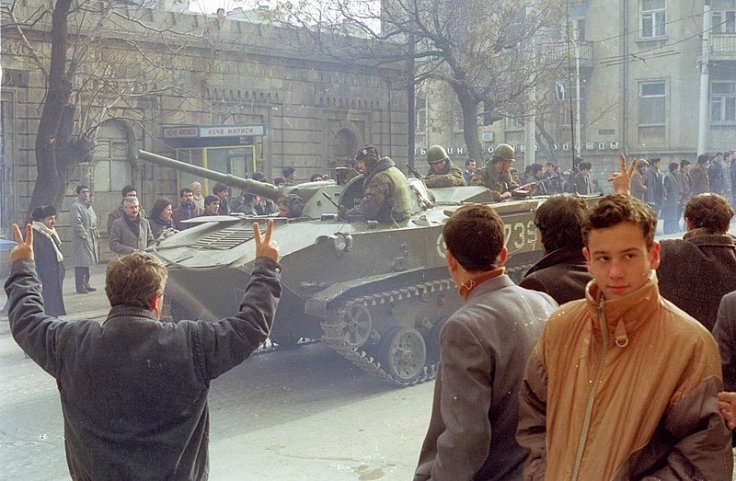The conflict between Armenia and Azerbaijan has escalated, with the rivals confirming that clashes continued overnight. Azerbaijan has said it will retake the disputed Nagorno-Karabakh by force, and the Armenians have vowed they will fight until death to protect the territory. Both the countries have declared emergency martial law, and troop mobilization is in full swing in Armenia, anticipating a full blown conflict.
There is hectic activity in regional capitals, while the United Nations has expressed extreme concern over the developments. Russia is in touch with the Armenians while Turkey has offered full support to Azerbaijan, terming Armenia as the 'biggest threat to regional peace'.
There are loud calls in Azerbaijan capital Baku to retake the ethnic Armenian Nagorno-Karabakh enclave from the Armenian control, while Armenians have said they are tired of Azeri threats. The Armenian defence ministry said on Monday that there was fighting throughout the night, while Baku said Armenians shelled the border towns.
Both Armenia and Azerbaijan have reported civilian casualties in the latest conflict. Nagorno-Karabakh said on Monday 15 more of its troops were killed in Azeri attacks.

What's Nagorno-Karabakh Conflict?
Nagorno-Karabakh is a primarily ethnic Armenian region but it is situated in the territory of ex-Soviet Azerbaijan. As per international law Nagorno-Karabakh is part of Azerbaijan but the majority ethnic Armenians have established self-government with the support of Armenia. The ethnic Armenians are majority Christians, while Azerbaijan is mainly Muslim, giving the conflict a religious undertone and linking it to the Ottoman era oppression of Armenian Christians.
History
In 1923, the Soviet Union recognized Nagorno-Karabakh as an autonomous 'oblast' within Azerbaijan. However, as the Soviet empire crumbled and both Armenia and Azerbaijan won independence from Moscow, fighting broke out in the region.
The calls in Nagorno-Karabakh to end the Azerbaijani rule escalated in 1991. The clashes resulted in the death of nearly 30,000 people, and eventually Azerbaijani troops were pushed out of Nagorno-Karabakh, a mountainous province inside the Azerbaijan territory.

1994 Ceasefire
A ceasefire was arrived at in 1994, and by then the Nagorno-Karabakh separatists, supported by Armenia, controlled the region as well as seven surrounding Azerbaijani territories. Though the ethnic Armenians in Nagorno-Karabakh declared independence after driving out the Azerbaijani troops, the move did not win international support.
By the time an internationally brokered ceasefire was agreed in 1994, ethnic Armenians controlled almost all of Nagorno-Karabakh, plus some surrounding Azerbaijan districts. This gave them a buffer zone, while also helping them maintain a land connection to the Armenian mainland.
The Azerbaijani threat to take back Nagorno-Karabakh, using military force if necessary, led to numerous conflicts in the following years. The biggest recent clash was in 2016, when nearly 200 people were killed. In July this year, at least 16 people died as hostilities resumed.
The Continuing Conflict

Though the 1994 ceasefire continues to hold in a technical sense, violence continued along Nagorno-Karabakh's border with Azerbaijan, as well as on the Armenia-Azerbaijan international border. "We are a step away from a large-scale war ... One of the main reasons for the current escalation is a lack of any proactive international mediation between the sides for weeks," Olesya Vartanyan of the International Crisis Group told AFP.
Role of Turkey
Turkey overwhelmingly supported Azerbaijan, terming Armenia the biggest threat to regional peace. Ankara, which has steadfastly refused to accept the 1915-16 massacre of more than a million Armenians as a genocide, is throwing its full weight behind Baku.
Over the last several decades, Turkey has tried to stymie Armenia, which lies in between Turkey and Azerbaijan. Ankara closed the common border with Armenia in 1993, a move that had immense impact on Armenia's economic growth. Though both the sides signed Protocols normalizing relations, the deal was never implemented.
What is Armenian genocide?
As per the International Association of Genocide Scholars (IAGS), "more than a million" Armenians died under the persecution of the Ottoman empire, which is modern day Turkey, during 1915-16. The Armenians were driven en masse from eastern Anatolia to the Syrian desert by the Turks. Thousands of them were killed while more perished due to starvation and diseases. While historians around the world say the mass murder was carried out in order to annihilate the Christian Armenian people, Turkey has held the view that there was no systematic plan of ethnic cleansing.









